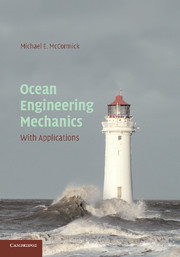Book contents
- Frontmatter
- Contents
- Preface
- Notation
- OCEAN ENGINEERING MECHANICS
- 1 Introduction
- 2 Review of Hydromechanics
- 3 Linear Surface Waves
- 4 Nonlinear Surface Waves
- 5 Random Seas
- 6 Wave Modification and Transformation
- 7 Waves in the Coastal Zone
- 8 Coastal Engineering Considerations
- 9 Wave-Induced Forces and Moments on Fixed Bodies
- 10 Introduction to Wave-Structure Interaction
- 11 Wave-Induced Motions of Floating Bodies
- 12 Wave-Induced Motions of Compliant Structures
- Appendices
- References
- Index
4 - Nonlinear Surface Waves
Published online by Cambridge University Press: 05 June 2012
- Frontmatter
- Contents
- Preface
- Notation
- OCEAN ENGINEERING MECHANICS
- 1 Introduction
- 2 Review of Hydromechanics
- 3 Linear Surface Waves
- 4 Nonlinear Surface Waves
- 5 Random Seas
- 6 Wave Modification and Transformation
- 7 Waves in the Coastal Zone
- 8 Coastal Engineering Considerations
- 9 Wave-Induced Forces and Moments on Fixed Bodies
- 10 Introduction to Wave-Structure Interaction
- 11 Wave-Induced Motions of Floating Bodies
- 12 Wave-Induced Motions of Compliant Structures
- Appendices
- References
- Index
Summary
The study of nonlinear waves began early in the nineteenth century. Results of the first studies of these waves were used to determine the quasi-static wave loads on ships and other tethered floating structures. Although the first analytical techniques were rather simplistic, these techniques were used well into the twentieth century. In the mid-nineteenth century, more mathematically sophisticated analytical methods were introduced. These methods are used by both physical oceanographers and ocean engineers in their respective predictions of real wave properties and the time-dependent loadings on offshore structures.
There are a number of theories that can be used to approximately predict the properties of nonlinear waves. Probably the earliest of these theories is that of Gerstner (1808). The theory of Gerstner is a geometric type, and is commonly referred to as the trochoidal theory. This name results from the predicted profile of the breaking wave (see Figure 3.1e) which, from Gerstner's theory, is a trochoid, having a cusp at the crest. The trochoidal theory is rotational in a hydrodynamic sense (see Section 2.3), with the rotational direction being opposite of that actually observed. Results of the theory are still used today by some structural naval architects to predict the extreme quasi-static wave loads on ship hulls in both sagging (crests at both the bow and stern, and the trough amidships) and hogging (troughs at both the bow and stern, and a crest amidships).
- Type
- Chapter
- Information
- Ocean Engineering MechanicsWith Applications, pp. 73 - 112Publisher: Cambridge University PressPrint publication year: 2009



